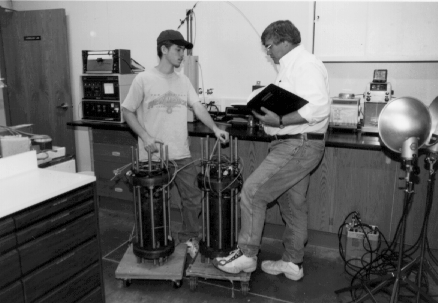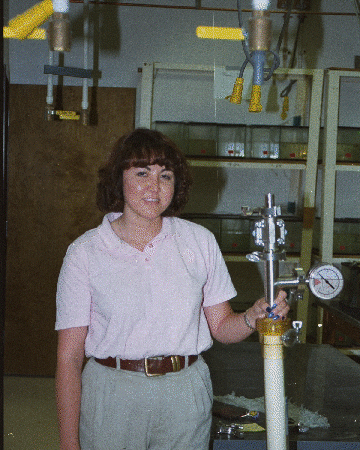Assuming New Mexico Governor Gary Johnson signs this year’s general government appropriations bill, the New Mexico Water Resources Research Institute will provide funding for at least two new projects through the 1999 WRRI Seed Money Research Program. Depending on the amount of state appropriations made available to the institute, other projects may be funded later this year.
The first of these projects recognizes that of the estimated 20 billion acre-feet of New Mexico’s water stored underground, only about 3 billion acre-feet is potentially recoverable fresh water. The rest is too saline for human consumption. Conventional reverse osmosis – a process used for purifying water whereby pressure is applied to saline water on one side of a semipermeable membrane, forcing freshwater through the membrane – has shown promise of providing an economical method of purifying saline and other impaired waters. However, a major limitation is its relatively large waste stream. The waste stream can be as much as 80% of the total volume treated. The high cost of waste disposal severely limits the use of reverse osmosis.

The goal of Dr. T.M. Whitworth's research is to reduce that waste stream to a solid, a reduction in waste volume of up to four orders of magnitude thus allowing all the water input into the system to be purified.
In a previous WRRI-funded project, Dr. Whitworth and his research assistant, Gina DeRosa, both of New Mexico Tech, were successful in precipitating heavy metals including copper, cobalt, and lead, from undersaturated chloride solutions forced through clay membranes, a process referred to as hyperfiltration. Metal chloride solutions are quite soluble, but not as soluble as sodium chloride, a common constituent of almost all waters. If Dr. Whitworth's waste reduction system is to be widely applicable, it must be able to precipitate highly soluble dissolved minerals such as sodium chloride as well as less soluble dissolved minerals.
Theoretical calculations suggest that it is not only possible to precipitate sodium chloride from an initially undersaturated solution passing through a membrane, but that it can be done at fluid pressures of less than 400 psi pressure, significantly less than those used in most reverse osmosis systems.
The secret seems to be in the use of an osmotically inefficient membrane, that is, one with low, but adequate, separation efficiency and low pressure requirements. Dr. Whitworth will use clay membranes because their osmotic efficiency is related to membrane compaction, which is simple to control experimentally.
Potential uses of the reverse osmosis waste reduction system are many in New Mexico. It could be used in the treatment of both irrigation water and river water to reduce total dissolved solids. Municipalities and individuals could use the system to treat saline and other impaired waters. It is hoped this project will improve the commercial viability of the method so that industrial partners can be attracted to make this process available to users in New Mexico.
Another project to be funded by the WRRI continues research under the direction of Dr. Kevin Oshima of New Mexico State University aimed at recovering viruses and Cryptosporidium oocysts from water. Although there is growing concern for the potential health risks associated with the presence of pathogens in our water, little data are available to determine how significant are these risks. To identify and quantify waterborne pathogens, methods are needed to reliably concentrate pathogens from drinking, surface and groundwater.
The U.S. Environmental Protection Agency has mandated that large water utilities in the U.S. test their source and product water for viral pathogens from surface and groundwater systems. There are difficulties associated with current methods for concentrating pathogens including time and expense as well as variable efficiency and consistency of virus and parasite recovery. Further, the use of different methods for detecting viruses, bacteria and protozoan organisms from water increases the complexity and expense.
As part of a previous WRRI-funded project, Dr. Oshima's laboratory has optimized two ultrafiltration systems (hollow fiber and tangential flow) to concentrate waterborne viruses under laboratory scale conditions. Now Dr. Oshima will scale-up the systems for use under field conditions and integrate the use of a PCR (Polymerase Chain Reaction) detection system to amplify nucleic acid from enteroviruses and Cryptosporidium oocysts to enhance the detection of these pathogens.

Dr. Oshima and his graduate assistants will attempt to:
1) optimize methods to recover viruses under field size (100-1000 L) samples;
2) determine the correlation between small and field scale testing for virus recovery;
3) determine the recovery efficiency of Cryptosporidium parvum oocysts from environmental water using a small scale hollow fiber ultrafiltration system; and
4) develop and optimize a downstream sample processing procedure leading to the concentration of the sample to less than 1 ml for the field scale samples.
Using ultrafiltration to concentrate viral particles in water was described by Dr. Oshima at last year's WRRI water conference. His presentation is contained in the conference proceedings which is available by contacting the WRRI at 505-646-4337 or emailing your request to coklett@wrri.nmsu.edu
